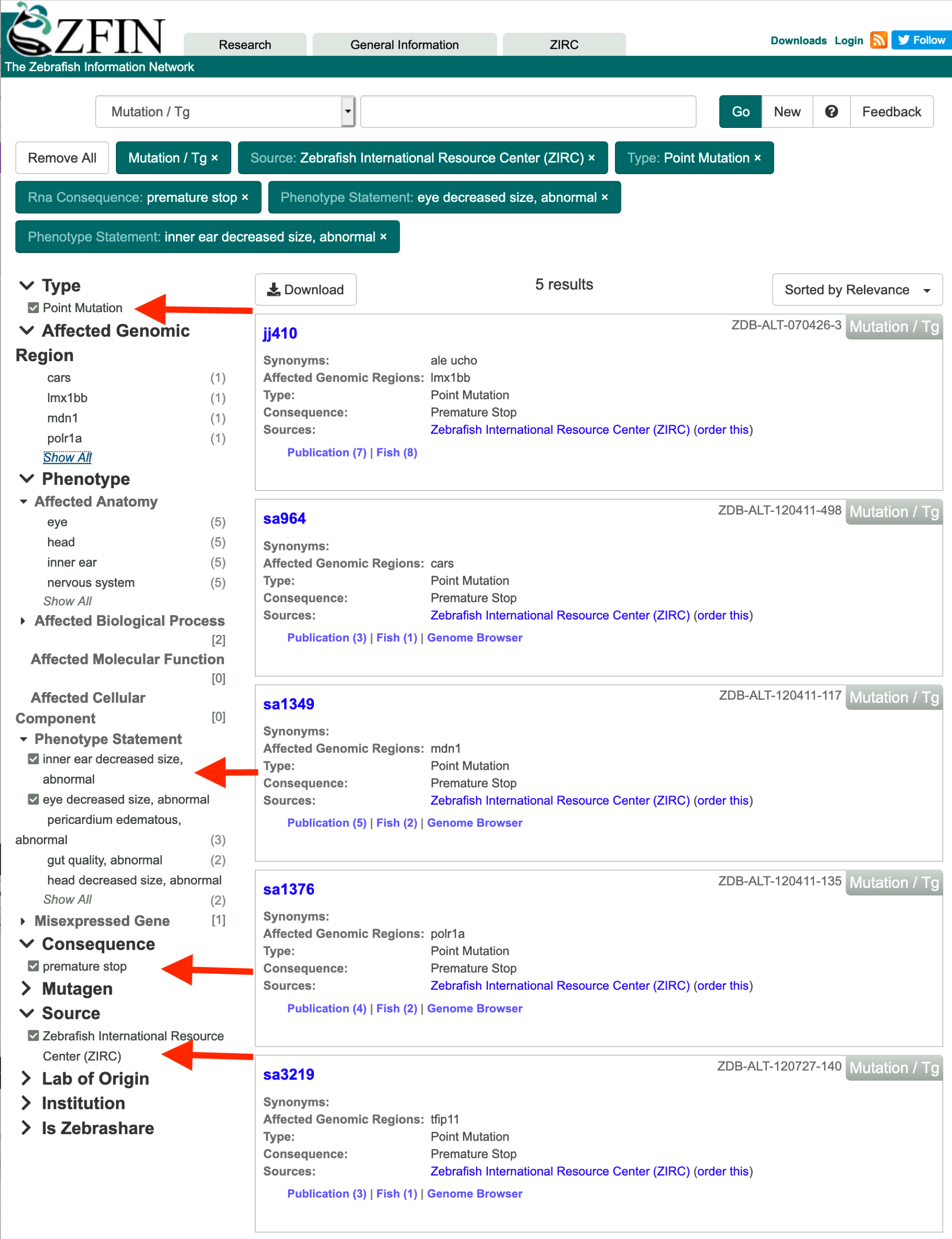...
- Go to the ZFIN home page and click in the text entry area for single box search and hit enter or click the "Go" button to access all data in the search interface.
- We are looking for mutants, so in the list of Categories at the left, select "Mutation/Tg".
- The result set now includes all the mutation and Tg records in ZFIN (currently 68,824). Now, filter that long list down to find just those mutants that meet our criteria.
- First, the mutant needs to be available from ZIRC, so click to open the "Source" filter, and select "Zebrafish International Resource Center (ZIRC)". Currently that filters the set down to 43,865 mutants/transgenics.
- Next, the desired mutant must be a point mutation. In the "Type" filter click "Point Mutation". That limits the set further to only include point mutations (31,566 currently)
- Then, the desired mutant should result in a premature stop. Click to open the "Consequence" filter and click "premature stop". That filters the set further to only include those features which have a premature stop as their consequence (20,181 currently).
- Finally, the desired mutant should have decreased eye and inner ear size. Click to open the 'Phenotype Statement" filter and click the "eye decreased size, abnormal". Today, that limits the resulting list of mutants to 25 candidates.
- Click on "inner ear decreased size, abnormal" in the "Phenotype Statement" filter. Today that filters the set of mutants down to just five mutants (jj410, sa964, sa1349, sa1376, and sa3219) (Figure 7).
- Clicking "Show All" in the "Affected Genomic Region" filter shows that these mutants are associated with the genes cars, lmx1bb, mdn1, polr1a, and tfip11.
- The "Phenotype Statement" Filter shows that two of these mutants are associated with an abnormal gut phenotype, and three are associated with an edematous pericardium phenotype.
Figure 7. Filtering to locate mutants which are available from ZIRC and are point mutations creating a premature stop and resulting in a phenotype including decreased eye and inner ear size.
Conclusion:
The above examples only scratch the surface of the functionality provided in the single box search filtering interface. Filtering data in the single box search limits the result set to only records which have the attributes you select from the filters. It is also possible to exclude results having one of the filter values by clicking on the small minus sign that appears beside each filter value when your mouse passes over it. The small plus sign that appears has the same effect as clicking on the term itself. This filtering approach shows you where the data are and how many records are available. The only values offered in the filters are values which will produce at least one record in the results. This eliminates blindly searching and getting no search results. Filter values are also marked with the number of search results that will be retained if you select that filter value, providing insight into the composition of your search result set in a way that direct searching cannot. Single box search currently supports searching and filtering for genes, transcripts, expression, phenotype, human disease, Fish, reporter lines, mutation/Tgs, constructs, morpholinos, TALENs, CRISPRs, antibodies, markers/clones, published figures, anatomy and GO terms, publications, and people, labs, and companies...or...you can search across all these categories at once. Come up with your own questions and see if single box search can find the answers! As always, we welcome your feedback on single box searching and filtering, or any other aspect of ZFIN, at zfinadmn@zfinzfinadmn [at] zfin.org.
